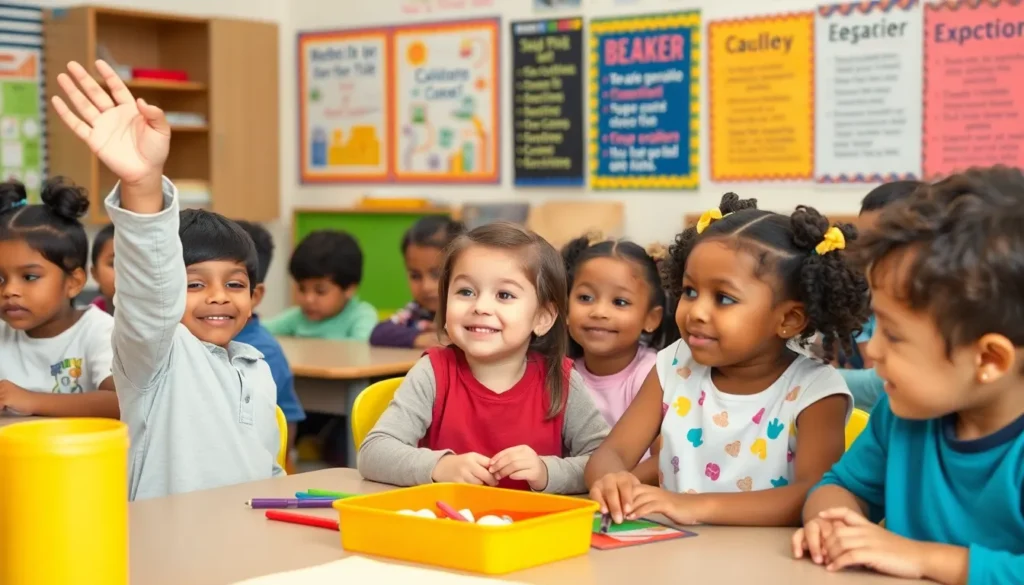Table of Contents
ToggleDiscipline might sound like a buzzkill, but it’s the secret sauce that turns chaos into harmony. Imagine a world where kids actually listen and adults don’t lose their minds over spilled milk. The discipline approach isn’t just about rules; it’s about creating an environment where everyone thrives. By focusing on positive reinforcement and clear expectations, this method transforms tantrums into triumphs.
Overview of Discipline Approach
Discipline involves more than just enforcing rules; it emphasizes fostering an environment that encourages positive behavior. This approach relies on positive reinforcement, which includes recognizing and rewarding good actions, leading to more desirable behaviors. Clear expectations serve as a foundation for this practice, guiding children toward understanding appropriate actions and consequences.
Creating a structured atmosphere promotes security and clarity in children. When they know what to expect and how to behave, it significantly enhances their confidence. The discipline approach also helps reduce stress for adults, who feel more equipped to manage challenging situations. Instead of reacting with frustration to tantrums, caregivers can utilize strategies that transform these incidents into learning opportunities.
Common techniques used in this discipline approach include setting specific boundaries and consistently enforcing them. Establishing routines further contributes to a sense of stability, allowing children to thrive. Positive interactions strengthen the child-caregiver relationship, encouraging open communication and trust.
Incorporating this method leads to notable improvements in behavioral responses. Many educators and parents report that applying a consistent, disciplined approach can minimize disruptive behavior, fostering a supportive learning environment. Such an environment not only benefits children but also creates a more enjoyable experience for adults.
Key Principles of Discipline Approach

The discipline approach emphasizes fundamental principles that promote a positive environment. Each principle plays a crucial role in shaping behavior and fostering a supportive atmosphere.
Positive Reinforcement
Positive reinforcement encourages desirable behavior through rewards. This technique involves recognizing and celebrating good actions. When children receive praise or tangible rewards for their behavior, they feel motivated to repeat those actions. Examples of positive reinforcement include verbal affirmations or earning privileges. Implementing this method strengthens the child-caregiver bond and boosts self-esteem. It’s essential to give immediate feedback, as this helps children connect their actions with positive outcomes. Many educators observe significant improvements in motivation and overall behavior when applying this approach.
Consistency in Rules
Consistency in rules establishes clear expectations for behavior. Children thrive when they know what is expected of them and the consequences of their actions. Establishing specific boundaries reduces confusion and creates a sense of security. Caregivers must apply the same rules consistently to reinforce integrity and trust. Regularly reviewing and discussing rules with children ensures understanding and compliance. Examples of consistent rules include bedtime routines and homework schedules. This structured approach helps children adapt to expectations, ultimately leading to improved behavior and a harmonious environment.
Benefits of Discipline Approach
A discipline approach fosters numerous advantages for both children and adults. Clear guidance and positive reinforcement lead to significant improvements in behavior.
Improved Behavior
Positive reinforcement contributes to better behavior in children. Recognizing and rewarding desirable actions encourages repetitions of those actions. Parents and educators observe fewer tantrums and disruptive behaviors when a structured environment supports consistent expectations. Children feel secure, knowing the boundaries established. Consistency in rules eliminates ambiguity, helping children understand the consequences of their choices. Structured settings promote self-discipline and personal accountability, creating an overall sense of responsibility in children.
Enhanced Learning Environment
An effective discipline approach enhances the learning environment significantly. Clear expectations foster engagement and focus among students. When children understand the rules, they feel empowered to participate actively in their education. Positive interactions between caregivers and children establish trust, promoting a collaborative atmosphere. This method reduces classroom disruptions, allowing for more effective teaching and learning experiences. Ultimately, a supportive atmosphere nurtures curiosity, making learning enjoyable and beneficial for everyone involved.
Challenges of Implementing Discipline Approach
Implementing a discipline approach comes with specific challenges. Addressing these obstacles ensures a successful application of the discipline strategy.
Resistance from Students
Students may resist the discipline approach due to adjustments in their routines. Increased awareness of expectations can lead to frustration, especially if they perceive rules as restrictive. Some students react negatively when consistent boundaries are enforced. Change can be difficult; therefore, patience is crucial during this transition. Engaging students in discussions about the new approach often alleviates resistance. Listening to their concerns fosters cooperation and eases implementation.
Need for Training Educators
Training educators is essential for the discipline approach’s effectiveness. Many educators may lack experience with positive reinforcement techniques. Providing professional development opportunities ensures that staff understands key principles. Workshops focusing on conflict resolution, classroom management, and communication skills build educators’ confidence in applying discipline consistently. Support from experienced practitioners can enhance learning outcomes. When educators possess the necessary skills, they model appropriate behaviors and expectations more effectively.
Adopting a disciplined approach cultivates a nurturing environment that benefits both children and adults. It emphasizes the significance of positive reinforcement and clear expectations in shaping behavior. By establishing routines and consistent boundaries, caregivers can create a stable atmosphere that encourages growth and learning.
This method not only reduces disruptive behavior but also enhances the overall educational experience. With patience and communication, the challenges of implementing discipline can be navigated effectively. Investing in training for educators ensures they are equipped with the necessary skills to apply these principles successfully. Ultimately, a disciplined approach lays the foundation for a harmonious and supportive environment where everyone thrives.





